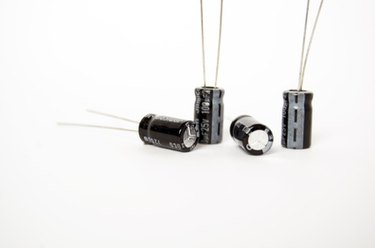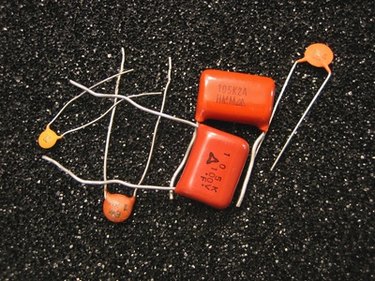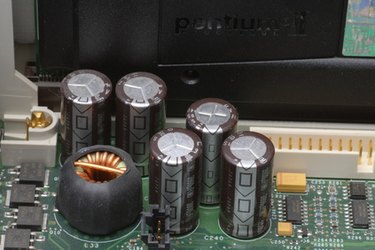
A capacitor is an electronic device constructed using two plates of electrically conductive material separated by a non-conductive material, or insulator. It is used in electrical applications and circuits using A/C (alternating current) and D/C (direct current) to achieve certain results based on the capacitor's ability to store and discharge current.
History of Capacitors
Video of the Day

The first device that can be called a capacitor is the Leyden jar which was discovered by German inventor Ewald Georg von Kleist in 1745. It was a glass jar filled partially with water and plugged with a cork, which had a wire running through it. The wire dipped into water and when contacted with a static electricity producer, caused the jar to become charged. The jar discharged when the wire contacted or came close to a conducting material. The following year a Dutch physicist named Pieter van Musschenbroek of the University of Leyden independently discovered the same principle of capacitance.
Video of the Day
Types of Capacitors
Capacitors are categorized in several ways as pertains to construction design and materials used in manufacturing, but there are basically just two essential types as far as electricity is concerned: polarized and non-polarized. Polarized capacitors, known as electrolytic capacitors, must strictly conform to polarity and voltage. Non-polarized capacitors only have voltage rating limitations.
Capacitors in DC Circuits

The two plates of a capacitor, electrically insulated from each other, store energy in the form of capacitance. When DC current is applied to a circuit with only resistance and capacitance, the capacitor will charge to the level of the applied voltage. Since DC only flows in one direction, once the capacitor is fully charged there is no more current flow. This characteristic allows capacitors to "block" DC current flow.
Capacitors in AC Circuits
In AC circuits the alternating current periodically changes directions, charging the capacitor in one direction and then the other. As the plates discharge during the change of direction, the capacitor output current alternates in phase with the AC voltage. This is how capacitors are said to "pass" AC.
Uses For Capacitors

Capacitors find many uses in electrical and electronic circuits. They can be used in coupling circuits, decoupling circuits, filtering circuits and in power supplies to smooth the output signal. Capacitors find specific uses for circuits using high or low frequencies, making use of capacitors' inherent characteristics and how they react to different ranges of frequencies by exhibiting varying levels of impedance.